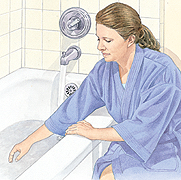Treating Hemorrhoids: Self-Care
Follow your doctor’s advice about caring for your hemorrhoids at home. Some treatments help relieve symptoms right away. Others involve making changes in your diet and exercise habits. These can help ease constipation and prevent hemorrhoid symptoms from coming back.

Relieving Symptoms
Your doctor may prescribe anti-inflammatory medication to help ease your symptoms. The following tips will also help relieve pain and swelling.
-
Take Sitz Baths. Taking a sitz bath means sitting in a few inches of warm bath water. Soaking for 15–20 minutes twice a day can provide welcome relief from painful hemorrhoids. It can also help the area stay clean.
-
Develop Good Bowel Habits. Use the bathroom when you need to. Don’t ignore the urge to go. This can lead to constipation, hard stools, and straining. Also, don’t read while on the toilet. Sit only as long as needed. Wipe gently with soft, unscented toilet tissue or baby wipes.
-
Use Ice Packs. Placing an ice pack on a thrombosed external hemorrhoid can help relieve pain right away. It will also help reduce the blood clot. Use the ice for 15–20 minutes at a time. Keep a cloth between the ice and your skin to prevent skin damage.
-
Use Other Measures As Directed By Your Doctor.
Add Fiber to Your Diet
Adding fiber to your diet can help relieve constipation by making stools softer and easier to pass. To increase your fiber intake, your doctor may recommend a bulking agent, such as psyllium. This is a high-fiber supplement available at most grocery and drugstores. Eating more fiber-rich foods will also help. There are two types of fiber:
-
Insoluble fiber is the main ingredient in bulking agents. It’s also found in foods such as wheat bran, whole-grain breads, fresh fruits, and vegetables.
-
Soluble fiber is found in foods such as oat bran. Although soluble fiber is good for you, it may not ease constipation as much as foods high in insoluble fiber.
Drink More Water
Along with a high-fiber diet, drinking more water can help ease constipation. This is because insoluble fiber absorbs water, making stools soft and bulky. Be sure to drink plenty of water throughout the day. Drinking fruit juices, such as prune juice or apple juice, can also help prevent constipation.
Get More Exercise
Regular exercise aids digestion and helps prevent constipation. It’s also great for your health. So talk with your doctor about starting an exercise program. Low-impact activities, such as swimming or walking, are good places to start. Take it easy at first. And remember to drink plenty of water when you exercise.
High-Fiber Foods
High-fiber foods offer many benefits. By making your stools softer, they help heal and prevent swollen hemorrhoids. They may also help reduce the risk of colon and rectal cancer. Best of all, they’re usually low in calories and taste great. Here are some examples of fiber-rich foods.
-
Whole grains, such as wheat bran, corn bran, and brown rice.
-
Vegetables, especially carrots, broccoli, cabbage, and peas.
-
Fruits, such as apples, bananas, raisins, peaches, and pears.
-
Nuts and legumes, especially peanuts, lentils, and kidney beans.
Easy Ways to Add Fiber
The tips below offer some simple ways to add more high-fiber foods to your meals.
-
Start your day with a high-fiber breakfast. Eat a wheat bran cereal along with a sliced banana. Or, try peanut butter on whole-wheat toast.
-
Eat carrot sticks for snacks. They’re easy to prepare, taste great, and are low in calories.
-
Use whole-grain breads instead of white bread for sandwiches.
-
Eat fruits for treats. Try an apple and some raisins instead of a candy bar.
|